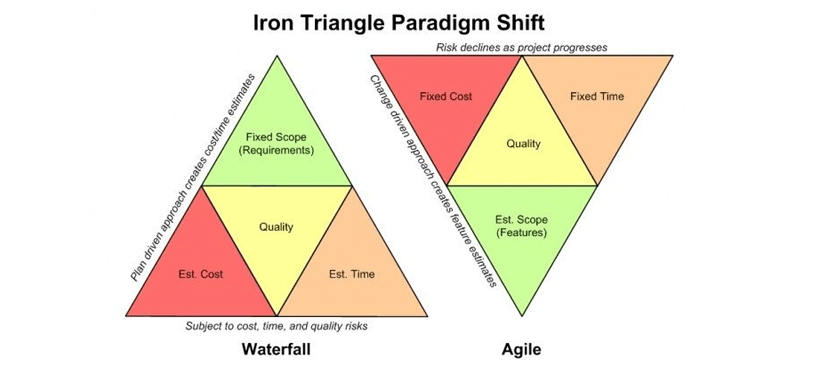
Click the button to start reading
Agile Iron Triangle: What It Is and How It Works
What’s the one thing all Agile software development projects have in common?
Answer: Goals.
Goals set the foundation of Agile projects, the objectives to be achieved by the end date. But goals also form a core part of each 2-week sprint. Each project has its own requirements:
- Achieving results by a certain date
- Working within a specific budget range
- Meeting or exceeding stakeholder expectations
- Optimizing the use of available resources and cutting waste
It’s not an easy task to keep a project moving while working within the constraints you can’t control. These constraints are considered to be “iron” – one can’t be moved without affecting all the others.
Balance is needed to keep a project moving.
Traditionally, projects would turn to the Iron Triangle, a framework managers have been using for years.
In this article, we’re looking at the Iron Triangle in Agile and how Agile teams can utilize this method of project management. We’ll also compare how the traditional Iron Triangle differs from the version used in Agile.

Understanding the Iron Triangle
Dr. Martin Barnes developed the Iron Triangle project management concept in 1969, and it’s become a go-to method of running projects ever since. It follows a waterfall approach to development and acknowledges three main constraints for the triangle:
- Scope
- Time
- Resources
It’s these vertices that are fundamental to every project. If one fails, the others are affected too. For example, let’s assume the project has an unmoveable delivery date, but the project team realizes that the current scope means they won’t be able to make it.
There are two options for the team: reduce the scope of the project or add more resources to the team, which will drive up costs.
As project methodologies have evolved and changed, Agile has become more commonplace. It allows for better collaboration throughout the team and makes it easier to iterate and adapt to changing circumstances. So, how does the Iron Triangle change for Agile?
Bringing the Iron Triangle to Agile
Since the Iron Triangle is intended to be inflexible, it’s hard to directly translate this method into Agile, which prioritizes flexibility.
However, as part of the Agile Manifesto, one of the signatories, Jim Highsmith, proposed an updated version of the Iron Triangle that better suits Agile projects. Known as the Agile Triangle, the three angles are updated to:
- Value: Measured by the stakeholders, value should reflect their expectations.
- Quality: Providing the highest-quality product possible in order to satisfy the customer’s expectations.
- Constraints: Here are the original elements of the Iron Triangle–scope, time, and resources.
This version of the triangle better reflects Agile’s focus on being adaptive, iterative, and value-driven. In Agile, flexibility is believed to be of greatest importance. Teams need to pivot based on feedback, changes in scope, and changes in the market.
Using the traditional Iron Triangle is too rigid to work in this methodology, so a switch to the Agile triangle is a better way to measure performance.

Who’s Involved in the Agile Iron Triangle?
The Agile triangle is a practical approach to project management with key players needed to execute. Here’s who plays an important role:
Product Owner
The Product Owner is responsible for the overall vision of the project.
It’s on them to define the value angle in the Agile triangle and ensure the stakeholder’s expectations are front and center of each sprint. They’ll take responsibility for the product backlog and ensure the most valuable features are prioritized and developed first.
They’ll be the ones to liaise with the stakeholders, which may involve communicating changes in project scope and putting in requests for changes to time and resource constraints.
Scrum Master
The Scrum Master will take ownership of the quality angle.
As the team’s lead Agile expert, they will guide the team and ensure they stick to the principles of Scrum and Agile. They should be on hand to answer any questions the team has about the Agile triangle and make suggestions to keep the project tracking smoothly.
Team
The team, consisting of developers, testers, designers, and other essential roles, work within the constraints angle.
Time, scope, and resources will play a big part in how they work, but it will also be their job to deliver on the vision and quality angles. Collaboration between the teams is one of the benefits of Agile, so they’ll need to be open to sharing insights and responding to feedback.
Team members should play an active role in the sprint planning and retrospective meetings, so they’re always adapting and iterating. Each sprint should become more effective as a result, helping the team to stay within the iron constraints.
Every member of the team, including the product owner and scrum master, should be committed to continuous improvement. Feedback loops help to bring the stakeholder’s vision to life while prioritizing quality.

Challenges and Solutions of the Iron Triangle in Agile
The Agile Iron Triangle presents a transformative approach to project management; however, its implementation does come with its own set of challenges.
One common hurdle teams familiar with traditional project management is resistance to change. Agile is a modern approach that may be at odds with the instincts and habits of a traditional team.
Flexibility may not come naturally to those who are used to the Iron Triangle as devised in 1969. It is inflexible by design, but adapting it for Agile has meant reimaging its core principles. Those used to a fixed scope may find the fluidity of Agile unsettling at first. It will be the job of the scrum master to nurture people through this.
Conducting regular workshops and training sessions can help teams understand the value of Agile, making the transition smoother.
Maintaining quality is another challenge with the Agile Iron Triangle. Since Agile relies on rapid iteration and frequent releases, there’s every risk that quality could be compromised to finish deliverables on time.
Agile is hardwired to combat this, but it requires honesty and open communication from the team. If the scope needs to change or more time is needed to complete a feature, the team needs to be able to voice these concerns early so they can be addressed in good time. Emphasis is always placed on quality, as evident from its inclusion as a vertex in the Agile triangle.
New teams to Agile may also struggle with the iterative approach to development. Projects are broken into smaller, more manageable “sprints,” typically lasting for two weeks. Traditional development may have treated projects as one-complete task rather than focusing on two weeks at a time.
But this approach is how a greater focus on the three vertices can be achieved. At the end of each week, the team holds a Sprint Retrospective meeting to focus on the work performed in the preceding two weeks.
During this meeting, inefficiencies can be discovered, and thanks to the iterative approach to development, solutions are put in place for the next sprint.
Conclusion
The Agile triangle is a happy marriage between traditional and modern approaches. While the traditional Iron Triangle has served its purpose for many years, helping teams to work within the unmoveable “iron” constraints.
But modern teams need more fluidity. It’s expected from stakeholders and easier than ever to achieve with the superior connection offered by the internet and modern technology. Switching to the Agile triangle still acknowledges and respects the Iron Triangle constraints but approaches them with the flexibility Agile is built for.
So, whether you’re an experienced project manager or a team member stepping into the Agile world for the first time, remember that the benefits of Agile are its adaptability and iterative approach to development. The Agile Iron Triangle helps to keep projects grounded while providing a framework for teams to consistently deliver on the stakeholder’s vision.
















